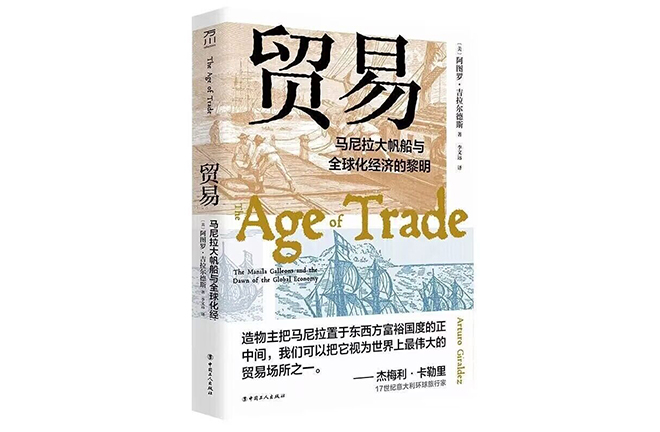Galleon Trade linking China with Latin America

FILE PHOTO: The Age of Trade: The Manila Galleons and the Dawn of the Global Economy by Arturo Giraldez
To maintain colonial rule over Latin America and the Philippines, Spanish colonizers established a galleon trade route in 1565 from Cebu Island in the Philippines to Acapulco in Mexico. This galleon trade lasted until 1815, spanning two and a half centuries. Each June, galleons departed from Cavite, south of Manila, riding the southwest monsoon northward to reach the port of Acapulco, covering over ten thousand nautical miles and taking about six months. The return trip, aided by ocean currents, took only three months. The goods they transported from Manila to Acapulco included silk, porcelain, tea, lacquerware, cotton fabrics, ivory, and carpets from China, Japan, India, Persia, and other Asian countries, as well as woven products, pearls, and wood carvings from the Philippines. These goods were then distributed throughout Mexico and other Spanish colonies in Latin America and re-exported to Spain. The return journey primarily carried Spanish silver coins, copper, and cocoa.
Silk-silver exchange
The galleon trade was essentially based on trade with China. Since more than 90% of the goods loaded on the Manila galleons were Chinese products, primarily silk and silk fabrics, the galleons were also known as the “Silk Ships.” In 1588, the number of Chinese merchant ships loaded with silk, porcelain and other essentials sailing from Yuegang Port in Fujian to Manila peaked at 46, and averaged 37.2 per year between 1609 and 1612. From the late 16th century to 1644, nearly a thousand Chinese merchant ships legally traveled to Manila, with additional vessels arriving through smuggling and other means. By the early 17th century, import taxes on Chinese goods accounted for about 80% of Manila’s total import taxes, reaching as high as 92.06% between 1641 and 1642.
Since local colonizers in Mexico could not produce any goods that would appeal to the Chinese, they relied on American silver to balance trade deficits. German-American scholar Andre Gunder Frank noted that China’s unparalleled manufacturing and export advantages in silk and porcelain led to a consistent trade surplus with other countries, which had to pay China in silver to conduct business. It is estimated that between 1565 and 1820, Mexico sent 400 million pesos worth of silver to Manila, most of which then flowed into China. Hence, the trade relationship between China and Mexico via Manila was essentially an exchange of Mexican silver for Chinese silk. The Manila galleon in the 16th century represented a unique and capital-intensive long-distance trade route.
Chinese influence via Galleon Trade
Upon the establishment of the galleon trade, Spanish colonial authorities were quick to implement strict trade monopoly policies restricting the number of ships, tonnage, cargo capacity, and total trade value to prevent Chinese and other Asian goods from dominating the Latin American market and to extract high monopoly profits. It has been estimated that Spanish colonizers reaped enormous profits of 600% to 800% from the galleon trade.
Affordable and high-quality Chinese goods, along with tea plants, citrus fruits, cherries, and other crops, were introduced to Latin America through the galleon trade, diversifying local lifestyles, fashion, and even dietary traditions. From the late 17th century to the mid-18th century, as Rococo art flourished, the upper classes of Latin American colonies favored oriental styles and tastes, with Chinese wallpaper, screens, lacquered cabinets, hardwood furniture, landscape paintings, tablecloths, curtains, umbrellas, and fans becoming highly fashionable. Women considered wearing Chinese silk chic, Mexico saw the emergence of new clothing styles like the “Chinese-style dress,” and drinking Chinese tea became a trendy habit. The influx of Chinese raw silk and porcelain promoted the development of Mexico’s silk weaving and porcelain industries. In 1637, silk weaving workshops in Mexico, which used Chinese raw silk, employed 14,000 workers. By the late 18th century, Puebla alone had 46 porcelain workshops, making it the center of the Latin America porcelain industry. Additionally, many Chinese people arrived in Spanish Latin America with the Manila galleons, settling down and working as artisans, doctors, and in other professions, contributing to local economic and social development. By the late 16th century, Chinese communities had formed in Peru and Mexico, integrating Chinese customs such as eating Chinese food and setting off fireworks into local traditions.
Influence from Latin America
The massive influx of American silver through the galleon trade into China facilitated the monetization of silver during the Ming and Qing dynasties. From 1565 to 1815, the Spanish colonial authorities in the Americas sent 1 million to 4 million pesos of silver annually to Manila to purchase Chinese raw silk, silk fabrics, and other goods. By the 18th century, more than 3.5 million taels of silver flowed into China annually. The significant increase in China’s silver reserves during the reign of the Wanli Emperor (r.1573–1620) enabled minister Zhang Juzheng to successfully implement fiscal reforms, with silver monetization accounting for 41%.
Additionally, the export of a large quantity of Chinese goods to Spanish Latin America and other regions facilitated early capital accumulation and the emergence of capitalism in China during the Ming and Qing dynasties. Crops from Spanish America, such as sweet potatoes, corn, potatoes, tobacco, sunflowers, and peanuts, were introduced to China via the Manila galleons. The introduction of sweet potatoes and corn, in particular, changed China’s traditional agricultural landscape, leading to significant increases in grain production and population growth. The introduction of chili peppers, pineapples, and other American crops also diversified Chinese dietary choices.
Liu Ziqiang is a professor from the School of Philosophy and Historical Culture at Xiangtan University.
Edited by REN GUANHONG
